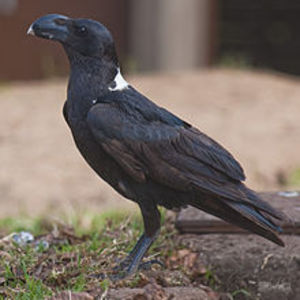 The white-necked raven is about 24 inches long and has a shorter tail than the common raven, as well as a deeper bill with a white tip that is almost as strongly arched as that of the thick-billed raven. Though predominantly black, the throat, breast and neck show a faint purple gloss. There is a large patch of white feathers on the nape of the neck. It soars well with a shallower wingbeat than other Corvidae. This raven is often described as having a sore throat, it has very similar calls to the common raven, but with a more husky note. It has a croak like the other raven species but with a more whispering note.
The white-necked raven is about 24 inches long and has a shorter tail than the common raven, as well as a deeper bill with a white tip that is almost as strongly arched as that of the thick-billed raven. Though predominantly black, the throat, breast and neck show a faint purple gloss. There is a large patch of white feathers on the nape of the neck. It soars well with a shallower wingbeat than other Corvidae. This raven is often described as having a sore throat, it has very similar calls to the common raven, but with a more husky note. It has a croak like the other raven species but with a more whispering note.
Location: Animals Formerly at Zoo
Share:
Range
Eastern and southern Africa in open mountainous country.
Habitat
Quite commonly found in small towns and villages as long as there are mountains or hills for roosting and nesting relatively nearby.
Conservation Status
Least Concern
Primary Threats
Gestation
Incubation is between 21-26 days.
Litter
3 - 5 eggs
Behavior
Like most raven species, the White-necked raven form flocks after leaving their parents and once fully matured will pair off and form territories. It is often found in the company of other scavengers suck as kites or vultures.
Reproduction
Nests are bowls of sticks lined with grass, hair, and wool, found mainly on cliff ledges but occasionally found in trees.
Wild Diet
Most of this bird’s food is obtained from the ground, but it will take food from trees as well. It has been seen to drop a tortoise from a height on to hard ground, preferably on rocks, and then swoop down to eat it, or even pick it up again if not sufficiently broken. White-necked ravens will also readily take carrion from road kills. Fruit, grain, insects, small reptiles, peanuts, and human food are also readily taken and the bird forages in back yards and gardens quite openly.
Zoo Diet

